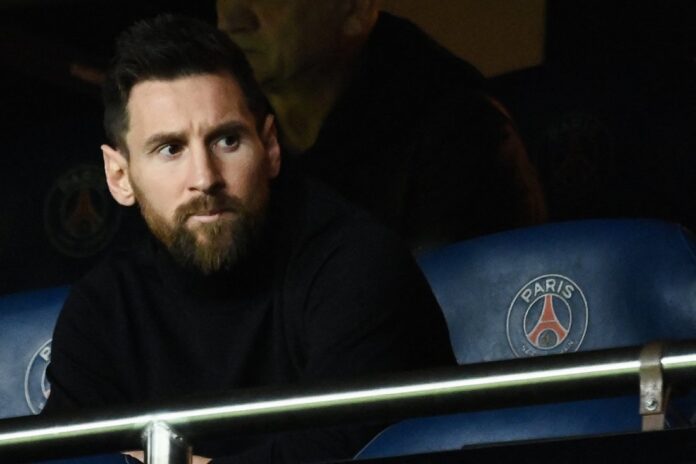Lionel Messi’s latest, and likely last, assault on the World Cup has garnered a Middle Eastern flavor.
If the game’s greatest talent is to belatedly lift the sport’s grandest trophy this winter, he’ll do it in Qatar — while employed by Qatar Sports Investments’ Paris Saint-Germain.
The 35-year-old will take to the pitch in Doha on Nov. 22 for Argentina’s Group C clash with Saudi Arabia at Lusail Iconic Stadium.
By then, he and his colleagues will have finalized their World Cup preparations in Abu Dhabi, with an open training session held at Al-Nahyan Stadium on Nov. 13 and a final friendly tune-up on Nov. 16 at the 42,000-capacity Mohammed bin Zayed Stadium.
It is the symbiotic relationship between these Gulf neighbors that holds intrigue. Just what is La Albiceleste likely to gain from a run-out versus FIFA’s 70th-ranked country, and one recently dismantled 4-0 by South American also-rans Venezuela?
Conversely, can Saudi Arabia expect to glean anything from their vaunted opponents’ taste of a local competitor as the region’s strongest football nation bids to prevent a repetition of 2018’s dispiriting start?
The attractions of Abu Dhabi are obvious.
Lionel Scaloni’s men land in an emirate which has cemented its reputation as a major global sports hub. The Ultimate Fighting Championship, NBA, Yas Marina’s Formula 1 circuit, Mubadala World Tennis Championship and golf’s Abu Dhabi HSBC Championship are just some of the competitions lured there.
Football has also played a sizeable role.
First-class facilities utilized at the 2019 AFC Asian Cup were further upgraded for the successful return of the FIFA Club World Cup in February of this year.
Close to the spectacular Sheikh Zayed Grand Mosque, eventual champions Chelsea trained on immaculate surfaces amid temperate conditions. Access is also consummately controlled — an important factor when Messi is in town.
The weather in mid-November will be similarly conducive to elite performance. Plus, an apt introduction to what awaits culturally an hour away by plane in Doha.
A familiar face is in opposition.
The UAE’s slender defeat to Australia in the AFC’s fourth-round playoff was overseen by the Argentine Rodolfo Arruabarrena. The UAE head coach was Scaloni’s contemporary in both the national setup and La Liga, and also led Boca Juniors from 2014 to 2016.
Switches from 4-3-3 and 4-2-3-1 formations represent a similar tactical approach to Herve Renard’s Saudi Arabia.
Both sets of players have also been exposed to Bert van Marwijk’s foundational methods.
The man who led the Netherlands to the 2010 World Cup final, also oversaw the Saudi qualification eight years later, before departing prior to the start of the tournament in Russia.
A mixed pair of spells in charge of the UAE would follow between 2019 and last February. This shared influence should not be underestimated.
The UAE cannot claim to be at the same level as the strengthening Green Falcons. They sit 19 places behind them in FIFA’s list. Their only entry to the World Cup was back in 1990, while Saudi Arabia will be making their sixth appearance next month.
The UAE’s clubs have failed to shine in the AFC Champions League during recent editions. Riyadh’s Al-Hilal have won it twice in three years.
March’s pivotal 1-0 qualifying victory against South Korea also stands out amid years of fitful performances, while the Saudis impressively topped their group ahead of Japan.
Last month’s UAE losses to Paraguay and Venezuela dampened enthusiasm gained during Qatar 2022’s near miss.
Yet, the domestic game has received a significant injection of quality and exposure this summer in the transfer market. Andriy Yarmolenko, Jason Denayer, Miralem Pjanic, Paco Alcacer, Adel Taarabt and Kostas Manolas are just some of those who have helped to rapidly raise standards.
Al-Jazira’s Ali Mabkhout is the best domestic center-forward currently in Asian club football and the fourth-highest active international goalscorer, with 80 strikes in 108 caps. Khalifa Al-Hammadi, Ali Saleh, Harib Suhail, Abdullah Ramadan and Majid Rashid are just some of the prospects who will relish sharing a pitch with Messi, Angel Di Maria and company.
There could even be a sentimental recall for Sebastian Tagliabue. A naturalized center-forward born north of Buenos Aires, back among the goals at Al-Wahda aged 37.
An appropriate challenge — not too stringent, but not too light — should be posed to Argentina less than a week prior to their World Cup 2022 kickoff.
Interpretation of the visitor’s team sheet in the UAE capital is an essential task for Renard and his technical staff.
Which partnerships stand out, are any players obviously being rested and what can be done to combat Messi?
If the likes of Mabkhout, Al-Hammadi and Saleh make an impression, it’ll raise confidence about the Saudis’ ability to do the same with superior players. Especially after goalless recent friendlies versus the US and Ecuador tempered expectations.
Hilal winger Salem Al-Dawsari will aim to be at his sparkling best after an appendectomy. Resolute center-backs Abdulelah Al-Amri and Ali Al-Bulaihi should line up behind a midfield which could yet contain respected veteran Salman Al-Faraj, plus a contrasting boost of energy in either Nasser Al-Dawsari or Ali Al-Hassan.
Firas Al-Buraikan’s encouraging form at Al-Fateh, allied with Saleh Al-Shehri’s return to action at Hilal, offers hope up top.
Renard has reshaped Saudi Arabia into a team which can expect to push Mexico and Poland hard for a knockout berth. They are, certainly, not just there to make up the numbers.
Argentina must be aware. Saudi Arabia’s stellar progression through Asian qualifying hints strongly at increased residual strength.
Seeds of a famous opening upset may, also, be planted across the border in Abu Dhabi.

